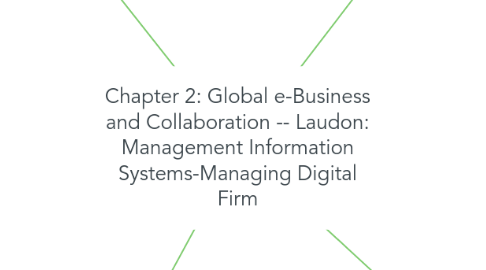
1. Importance of Cooperation and Termwork
1.1. Procter and Gamble
1.2. Importance
1.2.1. Changing Nature of Work
1.2.2. Growth of professional work –“interaction jobs”
1.2.3. Changing Organization of the Firm
1.2.4. Changing Scope of the Firm
1.2.5. Emphasis on Innovation
1.2.6. Changing Culture of Work
1.3. Benefits
1.3.1. Productivity
1.3.2. Innovation
1.3.3. Customer Service
1.3.4. Quality
1.3.5. Financial Performance
1.4. Building a Collaborative Business Culture
1.5. Tools
1.5.1. Email and Instant Messaging
1.5.2. Wikis
1.5.3. Virtual Worlds
1.5.4. Collaboration and Social Business Platforms
2. Relationship Between Business Processes and Information Systems
2.1. America's Cup
2.2. Business Processes
2.2.1. Workflows of Material, Information Knowledge
2.2.2. Sets of Activities, Steps
2.2.3. May be Cross Functional
2.2.4. May be Assets or Liabilities
2.2.5. Order Fulfillment Process Chart
2.3. Information Systems Enhance Business Processes.
2.3.1. Increased Efficiency (Automation)
2.3.2. New process (transformation)
3. Businesses: are a collection of business processes: assembling products, identifying customers, creating invoices, hiring employees...
4. Types of Systems
4.1. Transaction Processing System (TPS)
4.1.1. Record / Monitor Daily Outputs
4.1.2. Monitors Predefined Structured Goals
4.1.3. Serves Operational Levels
4.2. Management Information Systems (MIS)
4.2.1. Provide Reports on Performance
4.2.2. Answer Routine Questions
4.2.3. Serve Middle Management
4.2.4. Little Analytic Capability
4.3. Decision Support Systems (DSS)
4.3.1. Support Non-routine Decision-making
4.3.2. Use Information From TPS and MIS
4.3.3. Serve Middle Management
4.3.4. Data Driven
4.4. Systems for Business Intelligence
4.4.1. Class Software
4.4.2. Analyze Current and Historical Data
4.4.3. Serves Middle / Senior Management
4.5. Executive Support Systems
4.5.1. Address Non-routine Decisions
4.5.2. Incorporate Data About External Events
4.5.3. Serves Senior Management
4.6. Connecting Companies
4.6.1. Company Applications
4.6.2. Intranet and Extrnet
5. Enterprise Applications
5.1. Dominos Pizza
5.2. Systems for Linking the Enterprise
5.2.1. Collects data from different firm functions and stores data in single central data repository
5.2.2. Resolves problem of fragmented, redundant data sets and systems
5.3. Contain
5.3.1. Enterprise Systems
5.3.2. Supply Chain Management Systems (SCM)
5.3.3. Customer Relationship Management Systems
5.3.4. Knowledge Management Systems (KMS)
5.4. Enables
5.4.1. Coordination of Daily Activities
5.4.2. Efficient response to customer orders (production, inventory)
5.4.3. Provide valuable information for improving management decision making
5.5. Alternative Tools
5.5.1. Intranets and Extranets
5.5.2. E-business, E-commerce, E-government
